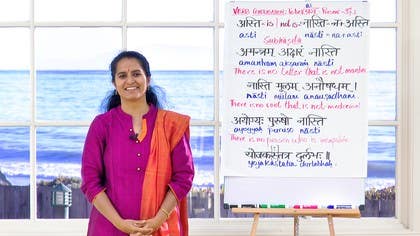Description
About This Video
Transcript
Read Full Transcript
Namaste dear friends, by now you must be getting more and more familiar with the verb conjugations in the present tense. What I have here for you is a kind of a review of these conjugations in the way that we normally learn it back home in India. So I would have grown up sort of memorizing these forms and I would suggest that now that you're familiar with the verbs already, look at them and then practice them in this way also. There are many ways of learning, you know. So whatever suits you but know that this is how it is presented in one place altogether.
So in the matrix of the verb, we had who is doing it, so this column tells us who is doing it, whether it's the third person doing it or like we saw that the second person formal also works here. It's normally not included in the traditional presentations of the verbs. It is normally understood later on, alright. So if you know the third person, in the back of your mind you know that it also works for the second person formal, right. So third person or the second person you and the first person I and if we have to go down the other columns, we have singular, dual and plural.
So these are the nine forms of any verb. You can have it in the present tense, future, past, etc, etc. But this matrix is what you need to understand. Set it up in your mind and it will be very easy to place the verbs there, right. So third person singular will be patati, studies, third person dual is patata, third person plural patanti, right, they read.
So I just say that again. He or she, one person reads patati, they too read patata, they plural many of them read patanti, patati, patatata, patanti, do that, patati, patata, patanti, lovely, alright. Now you singular read patasi, you dual, you too read patata, you many plural read patata, patasi, patatata, patatata, see that, patasi, patatata, patatata, make sure you take a good breath before you start and then I singular read aha, patami, we too read patawaha, we all read patamaha, patami, patawaha, patamaha, say that together, patami, patawaha, patamaha and we just learn two songs that can help us remember that aham, patami, Sanskritam and we did it in the plural, vayam, patam, sanskritam, got that. So as you've noticed, I haven't really put in any pronoun here and like I mentioned to you before, the moment I say thi or if I say patami, I already know who the pronoun is. So in Sanskrit, we try to avoid duplications unless we want to really make a point, we want to be emphatic about something.
So just to say patami is good enough, at a more subtle psychological level, it's a way of not reinforcing the ego, we don't have to say I, I read, you just say read and the I is understood because the way the word read is being conjugated, all right. So we'll do that once, just the verbs, keep the matrix clearly in your head. So patati, patatah, patanti, patasipatatah, patatatah, patami, patavah, patamaha. Close your eyes, just listen to it once, all right and then we'll do it together. So close your eyes now, listen, just listen to the word, pay attention to the ending, put it, so you're ready, we go, patati, patatah, patanti, patasipatatah, patatah, patami, patavah, patamaha.
Excellent, now open your eyes and look at it once, see the letters and just bring your consciousness to the endings, pay attention to the endings. So patati, patatah, tahah, patanti, patasipatatah, patatah, patami, patavah, patamaha, yeah, getting hang of it, lovely. If you want to probably just one, replace it with another verb like cad I eat, say it would be kadati, kadatah, kadanti, kadasi, kadatah, kadatah, kadami, kadavah, kadavah, kadamah, kadamah, fantastic, yeah, it's coming there, so great. What I also suggest that we can do here is get a kind of a visual indicator to helping us memorize it, just the way the letters look, we have patati, so remember t is in the first square, it's like in Sudoku when you fill up the different squares and you have to make sense of them there, so the mind is working in different ways, this is a kind of Sudoku in a sense, alright, so in the first one you have to put in the t like we see there. In the last square where it's plural, you add the numbers, the n sound, so nt like you see there.
The second one you drop the e and you drop the n and put the two dots, tahah, alright, so t then becomes see, so you can sort of remember it as you see, if you remember that you see, so in the verb when I start with you, if I had to put in an English verb for the fun of it, I will say you read see, just to make it clear, so you patati see and fully in Sanskrit, tvam patati see, okay, so just remember you see, if you can make that connection and I was simple because it's I me, so the ending has to have me in it, right, so t see me, now that and now if you look at here, there is a certain visual pattern, you have tahah, then the aspirated tahah, so an h comes in, tahah, tahah, no aspiration, tah, tahah, tah, like an l, so you have the stick here, this row which is t see me and then you have tahah, tahah, tah, and here it's aah, wah, for us and aah, mah, so visually you will see there is an l here with the dots at the end, with the aspirated basarga at the end, so tahah, tahah, aah, wah, aah, mah, that's one l and here you have the tahah, tah, tah, and this square that remains we had seen that you just have to add the n inside, nah, alright, that's just a kind of a visual tip to try and remember it for yourself, the pattern, now what we in India tend to also do is just remember the endings of it and that really simplifies how much we need to remember, so this entire chart of the present tense conjugation literally gets reduced to this which is, tithaah, nithi, sithah, tah, ami, aah, wah, amo, see that, tithaah, nithi, sithah, tah, ami, aah, wah, aah, mah, you notice that I have put a pink colour bracket here, that's because we don't necessarily always get the aah, like I mentioned with karomi, right, so it's really mi, wah, mah, that is correct, so tithaah, nithi, sithah, tah, mi, wah, mah, got that, want to try that once with me, tithaah, nithi, I'll write it in transliteration so that it can, it's easy for you, tithaah, nithi, thah, and then ami, I said the aah is not necessary always, aah, wah, again the aah is not always necessary, and amah, not always necessary, yeah, you want to say that together, tithaah, nithi, sithah, tah, ami, wah, mah, or mi, wah, mah, got that, you want to close your eyes once, I'll just do it once, I'll say it to you, and see if you can anticipate and get it right by yourself, so tithaah, nithi, sithah, tah, ami, aah, wah, mah, or mi, wah, mah, yeah, want to do that, what I suggest that you do is by yourself just take the first line and repeat it maybe 10 times, 15 times, tithaah, nithi, tithaah, nithi, tithaah, nithi, just play with it, tithaah, nithi, and you would know the conjugation of the third person singular dual plural, the matrix is very important, and then practice saying, sithah, tah, sithah, tah, sithah, tah, that's not tough, and then for the first person, mi, wah, mah, mi, wah, mah, mi, wah, mah, got it, yeah, I think you're doing very well, keep practicing, play with these as different sounds, but just understand that what these sounds are doing is also to help you clarify the world around you in some way or the other, enjoy and keep visiting the class, thank you.







You need to be a subscriber to post a comment.
Please Log In or Create an Account to start your free trial.